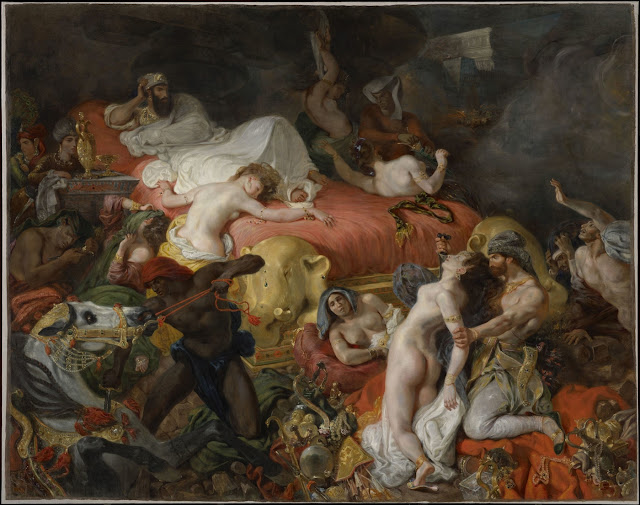20 PAINTINGS WORTH SEEING – PART III
11. BATTLE OF SAN ROMANO (NICCOLÒ MAURUZI DA TOLENTINO UNSEATS BERNARDINO DELLA CARDA)
“Niccolò Mauruzi da Tolentino unseats Bernardino della Carda” at the “Battle of San Romano” is an artwork of the Italian painter Paolo Uccello from cca 1435–1455. The panel is part of a cycle of three paintings which celebrate the victory of the Florentines over the Sienese troops and the alliance led by the Duke of Milan in the battle of San Romano (Pisa) in 1432. The paintings are in egg tempera on wooden panels, each with a length of more than 3 meters. Niccolò da Tolentino, the head of the Florentine army, is being depicted using his spear to strike and unseat Bernardino della Carda, the leader leading the opposing troops, while the battle rages around him. The direction of the shafts and crossbows, those held by the Florentine soldiers slightly inclined forward, those of the adversaries slightly backwards, predicts the outcome of the battle. The Uffizi panel is the central episode of the narrative sequence, which begins with the depiction of Niccolò da Tolentino leading the Florentine troops in the painting exhibited in the National Gallery in London and ends with the attack of Michelotto da Cotignola, an ally of the Florentines, illustrated in the panel in Louvre Museum from Paris.
The paintings were
commissioned by Lionardo Bartolini Salimberi, protagonist of Florentine
political life in the first half of the 15th century, for this palace in
Florence. The heirs of Lionardo Bartolini gave the paintings to Lorenzo the
Magnificent, who had them placed in his palace in via Larga. The additions to
the corners show the depiction of orange fronds, the "mala medica",
emblem of the Medici family. To render the armor and harnesses, Paolo Uccello
used a large quantity of metallic leaf, which was originally intended to give
the painting great richness and chromatic brilliance.
12. ST. SEBASTIAN
St. Sebastian is the subject of three paintings by the Italian Renaissance master Andrea Mantegna. The Paduan artist lived in a period of frequent plagues. Sebastian was considered protector against the plague as having been shot through by arrows, and it was thought that plague spread abroad through the air. In his long stay in Mantua, furthermore, Mantegna resided near the San Sebastiano church dedicated to St. Sebastian.
“St. Sebastian” from Louvre Museum was made in 1480 and was once part of the Altar of San Zeno in Verona. The painting presumably illustrates the theme of God's Athlete, inspired to a spurious sermon by St. Augustine. The saint, tied to a classical arch, is observed from an unusual, low perspective, used by the artist to enhance the impression of solidity and dominance of his figure. The head and eyes turned toward Heaven confirm Sebastian's firmness in bearing the martyrdom. At his feet two iniquitous people (represented by a duo of archers) are shown: these are intended to create a contrast between the man of transcendent faith, and those who are only attracted by profane pleasures.
Apart from the symbolism, the artwork is characterized by Mantegna's accuracy in the depictions of ancient ruins and the realist details, such as the fig tree next to the column and the description of Sebastian's body.
13. WOMAN WITH A PEARL
“Woman with a Pearl” is one of the most important works of the French painter Jean-Baptiste Camille
Corot, made in 1868 - 1870.
“Woman with a Pearl” is one of the human figures that Corot painted in the third part of his career. Many have speculated on the inspirational source for “The Woman with a Pearl” and opine that it may have been inspired by Leonardo Di Vinci’s “Mona Lisa”, because of the positioning of hands, facial expression, hair style of the sitter. Berthe Goldschmidt is posing in an Italian dress that Corot had brought back with him. Corot emphasized the harmonious unity of the sitter with the environment. Some people are confused with the title which indicates that the woman in the painting is wearing a pearl, when in fact it is a small leaf that hangs on her forehead. The pearl reflects the painter’s judgment on truthfulness. Charles Baudelaire (1821-1867) described the artist’s work as a "miracle of the heart and the mind".
“The Death of Sardanapalus” is an oil painting on canvas by Eugène Delacroix, finalized in 1827. It can be seen in the Musée du Louvre from Paris, France.
The painting is based on the tale of Sardanapalus, a king of Assyria, from the historical library of Diodorus Siculus, the ancient Greek historian, and is a romantic work. This painting uses rich, vivid and warm colours, and broad brushstrokes. It is inspired by Lord Byron's play “Sardanapalus” (1821).
The focus of “The Death of Sardanapalus” is a large bed draped in rich red fabric. A man lies on it with a disinterested eye overseeing a scene of chaos. He is dressed in flowing white fabrics and sumptuous gold around his neck and head. A woman lies at his feet, prone across the lower half of the large bed. She is one of six in the scene, all in various shades of undress, and all in assorted throes of death by the hands of the half dozen men in the scene. There are several people being stabbed with knives and one man is dying from a self-inflicted wound from a sword, and a man in the left foreground is attempting to kill an intricately adorned horse. A young man by the king's right elbow is standing behind a side table which has an elaborate golden decanter and a cup. There are golden elephant heads at the base of the bed, as well as various valuable trinkets scattered amongst the carnage. Several architectural elements are visible but difficult to discern in the background.
Delacroix used a painterly brushstroke, which allows for a strong sense of movement in the work. This scene is chaotic and violent, as showcased by the movement, weapons, and the colors used. The redness of the bed stands out against the somewhat obscured, dark background. The whiteness of Sardanapalus's robe, the creamy lines of the dying women's limbs, and the shimmers of gold objects throughout the scene pull the viewer's eye quickly around the painting.
There is asymmetry in the work, but the composition remains balanced. One woman reclined by an elephant head on the end of the bed is the only figure to engage with the viewer. Everyone else is focused on the task at hand: death.
15. STRATONICE AND ANTIOCHUS
“The Sickness of Antiochus” or “Stratonice and Antiochus” is an 1840 painting by the French artist Jean-Auguste-Dominique Ingres. It is exhibited in the Musée Condé from Chantilly.
The scene is being described in Plutarch's “Life of Demetrius” and attested in the Bibliotheca historica of Diodorus Siculus, Lucian, Appian and Valerius Maximus. Stratonice marries Seleucus I Nicator, King of Syria, but Antiochus, her husband’s son from a first marriage, falls so deeply in love with her that he falls seriously ill.
The painting depicts the moment when doctor Erasistratus understands the cause of his illness: Antiochus’s heartbeat quickens at the sight of Stratonice. The doctor has the old king believe that Antiochus is in love with his wife. Seleucus begs him to leave her, then, having learnt the truth, offers his wife to his son to save him. Seleucus is shown collapsed at the foot of the bed.
Which painting do you like the most? Please share in the comments.
REFERENCES
https://www.uffizi.it/opere/battaglia-di-san-romano
https://en.wikipedia.org/wiki/The_Battle_of_San_Romano
https://en.wikipedia.org/wiki/St._Sebastian_(Mantegna)
https://www.artisoo.com/OilPaintingBlog/woman-with-a-pearl-by-jean-baptiste-camille-corot/
https://en.wikipedia.org/wiki/The_Death_of_Sardanapalus
https://en.wikipedia.org/wiki/The_Illness_of_Antiochus
https://chateaudechantilly.fr/en/collection/antiochus-and-stratonice/
anasmagicworld art renaissance italianart frenchart europeanart creativity creativitymatters museedulouvre galeriauffizzi









Comments
Post a Comment